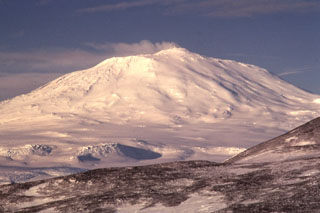Report on Erebus (Antarctica) — October 1978
Scientific Event Alert Network Bulletin, vol. 3, no. 10 (October 1978)
Managing Editor: David Squires.
Erebus (Antarctica) Lava lake activity persists; two small congealed lava flows, but reduced Strombolian activity
Please cite this report as:
Global Volcanism Program, 1978. Report on Erebus (Antarctica) (Squires, D., ed.). Scientific Event Alert Network Bulletin, 3:10. Smithsonian Institution. https://doi.org/10.5479/si.GVP.SEAN197810-390020
Erebus
Antarctica
77.53°S, 167.17°E; summit elev. 3794 m
All times are local (unless otherwise noted)
"The persistent anorthoclase phonolite lava lake at Mt. Erebus was observed on 26 October during a 5-hour visit to the summit crater by Philip R. Kyle and others. First discovered in December 1972 by Giggenbach and others, the lava lake gradually increased in size over a 3-year period, but has shown little change for the last 2 years. Two small congealed lava flows were visible on the S side of the inner crater. One flow originated from a small vent in the SW quadrant of the inner crater, the other flow apparently came from the lava lake.
"The general appearance of the lava lake was one of increased heat flow. The consolidated crust on the lake appeared to be less continuous and was broken by numerous E-W cracks. Larger areas of incandescent lava were visible compared to observations made in January 1978. The lava lake appeared to have increased in temperature, but no quantitative measurements are available. Small bubble-like degassing eruptions were common over most of the lake, with a greater concentration toward the W. The level of the lava lake appeared similar to that in January, although the surface area may have been reduced due to the collapse of the N crater wall. Minor collapse is common around the whole inner crater wall.
"Only a few small bombs were found on the crater rim and none were observed on the main crater floor, which suggests that there has been a considerable decrease in Strombolian eruptions compared to January, when up to six eruptions per day occurred. . . ."
Geological Summary. Mount Erebus, the world's southernmost historically active volcano, overlooks the McMurdo research station on Ross Island. It is the largest of three major volcanoes forming the crudely triangular Ross Island. The summit of the dominantly phonolitic volcano has been modified by one or two generations of caldera formation. A summit plateau at about 3,200 m elevation marks the rim of the youngest caldera, which formed during the late-Pleistocene and within which the modern cone was constructed. An elliptical 500 x 600 m wide, 110-m-deep crater truncates the summit and contains an active lava lake within a 250-m-wide, 100-m-deep inner crater; other lava lakes are sometimes present. The glacier-covered volcano was erupting when first sighted by Captain James Ross in 1841. Continuous lava-lake activity with minor explosions, punctuated by occasional larger Strombolian explosions that eject bombs onto the crater rim, has been documented since 1972, but has probably been occurring for much of the volcano's recent history.
Information Contacts: P. Kyle, Ohio State Univ.

